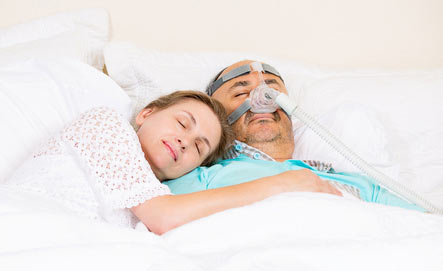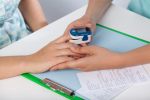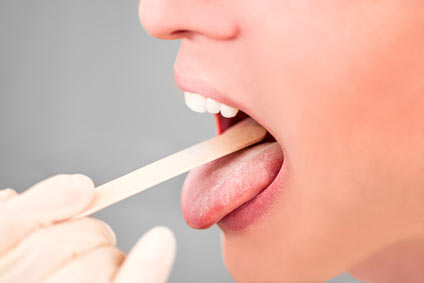CPAP Help - Tips for Beginners
Trouble assistance for patients with CPAP

In this page you'll learn how can CPAP help your sleep apnea syndrome, by improving the compliance with your breathing machine, fixing the most common CPAP problems and increasing your sleep quality.
If you're new to CPAP machine, the next help tips can make a positive experience during your treatment for sleep apnea.
Starting Your CPAP Therapy
After a patient has been informed of his sleep study results, he is ready to begin his CPAP consultation. This visit requiresalmost 45 minutes, as informed introduction to the therapy will produce a higher likelihood of compliance.
A spouse or bedmate is strongly encouraged to attend this appointment, and encourage a support system. This is crucial in achieving compliance with CPAP and receiving CPAP help from the partner.
In a perfect world, our physician and home healthcare suppliers would provide better assistance and customer service. They would offer us many mask choices and spend more time with us to assure we have the best mask for our individual faces.
Unfortunately, there isn't always the same. That's why you need more information. There are important facts to discuss and to inform, to assure your best success for CPAP treatment.
Tips & Tricks to Improve your CPAP Therapy
1. CPAP Mask Fitting
Many believe the mask is the key to PAP therapy, and numerous CPAP masks are available. There is a mask out there for you that will work. The question is which one is for you?
There are so many great masks on the market today. Yet, if there are 100, there may only be 5 that are best suited for YOUR face. You have to find the right mask....is it really that important? YOU BET!
Why the CPAP mask is crucial important for CPAP therapy?
Remember, you have to find a mask best suited to YOUR face...you have to find one that's comfortable - no mask should ever cause pain or discomfort.
No mask, if the right size and adjusted properly, should have to be tightened so that it causes skin irritation, or imbedded mask strap marks on your face, it should not leak.
Why it's so difficult to find a CPAP mask that fits properly?
What makes our faces unique so that there are so few that fit our individual faces? Here is what you need to know:
Most manufacturers say that their masks fit 80% of the population. It's probably true but that means 20% of us have difficulties. If you have problems with your mask, then maybe you are the one of those 20%.
You buy a shirt in small, medium, large or extra large. That's often a no-brainer. Not the same for masks. Most mask frames are about the same size, its the inner cushion that comes in S, M, L sizes etc.
So, if the mask frame is too large for your face and sits too high on the nose bridge, or lays on the sinus area, or presses the soft skin under your eyes, you get mask leak in to the eye area which you try to stop by pulling mask straps tighter and tighter until you get pain.
If your upper lip is narrow, the bottom of the mask frame will lay on your top lip - cause pain from having to over tighten and/or leak.
Here is my suggestion - You've looked at your face many times, but go to a mirror and look again with a new perspective. Pay attention to:
- How long is your face from hairline to chin,
- How long is your forehead,
- How long is your nose from bridge to base,
- How wide or narrow is your nose bridge,
- How wide is the base of your nose,
- How wide is your upper lip ( the skin area from the base of your nose to where your top lip starts),
- How close are your eyes set together,
- How long is your chin,
- How big is your head,
- How large are your nostril openings,
- Are your nostrils different sizes,
- Are your nostrils round or elongated
Taking in to consideration all of these possibilities, you can now understand why our faces are truly all different and there is no such thing in masks as one size fits most.
Also know that company to company sizing is different. Therefore if you wear a large in one brand, you might find you need a medium in another brand. You must try the masks on.
Since you want to find a mask that you can comfortably wear all night long with no leak, you should always make your choice wearing it with machine on and laying in your sleeping position.
In the Shop - Test the CPAP mask while lying on the bed
Remember that masks fit differently when you are standing, or sitting in a chair or on your bed. They may feel fine then, but once your machine is turned on to your pressure and you lay down in your sleeping position...all bets are off.
How to get the perfect fit with your CPAP mask?
When you DO find the right mask, always do your final fit/adjustments when you are laying in bed, machine turned on and you are laying in your sleeping position.
Loosen the straps and then pull slowly just until you get a good seal. If you have the right mask style and size, it's truly amazing how loose the straps can be still giving a good seal. Overtightening means you do not have the right style or size. One should never have to tighten a mask so much that it causes pain or skin irritation.
Most headgear comes in one size fits all. If you have a small head, there are some masks that offer size small headgear. It may be special order but they are available so ask.
Why the CPAP mask leaks appear?
If you have a narrow nosebridge, you will probably experience mask leak in the eye area. Find a mask that has a shorter frame as those mentioned above or consider nasal pillow interfaces then you won't have to deal with any mask frame laying on the nose.
If you have a narrow upper lip you may find that most traditional masks frames do not fit your face at all! Consider nasal pillow interfaces or the most petite size masks.
Nasal masks are generally easier to use, as they are less intrusive and certainly less claustrophobic, but individuals who are nighttime mouth breathers will require full face masks.
There is no single mask to satisfy everyone, therefore an assortment of nasal masks and full face masks should be maintained.
2. Using Ramp Feature
CPAP machines have features like ramp and expiration pressure relief like EPR ( ResMed) and C Flex, A Flex and BI Flex (Respironics).
This feature is patient controlled IF ENABLED and will reduce pressure automatically upon exhalation but only up to 3 cm h2O ( pressure points).
Most patients are issued CPAP because its cheapest and works for most - it blows one continuous pressure. If you need low to mid range pressure, this will probably work for you but there is an adjustment period.
However, some patients may be better suited for AutoPAP which works like a CPAP in that whatever pressure it delivers for inhalation pressure, you STILL have to be able to exhale over it.
3. Using a BiPAP machine when CPAP isn't working
Another CPAP help tip is to use BiLevel CPAP, the most expensive and rarely shown or discussed with the patient. And this is a shame because it can turn a non compliant patient into a success story.
It's usually only offered after CPAP trial and failure....and often after the patient is so frustrated they are ready to give up.
If you have trouble exhaling over the constant pressure of CPAP or AutoPAP and need a differential greater than 3 between IPAP (inhalation pressure) and EPAP ( exhalation pressure) then you are a candidate for BiLevel.
Don't be afraid to ask for it! The BiLevel machine can save your life when CPAP just would not work for you!
For more info about bi-level therapy, see BiPAP Machines.
I hope these CPAP help tips will be helpful for you. I want to leave you with this thought: You must take responsibility in choosing your own equipment.
Home › CPAP Machine › CPAP help tips







